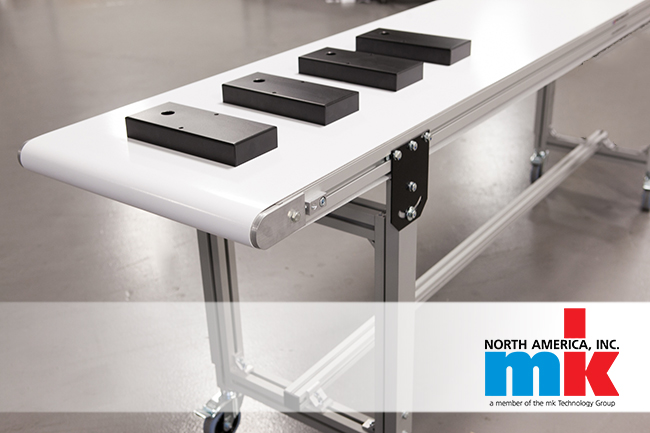What Is a Conveyor? Overview with Video
Posted on
Find all this info and more in the video below, courtesy of mk North America in partnership with Design World:
Conveyors move bulk materials (lumpy or granular materials in a free-flowing form) or discrete products (individual products such as single widgets or packaged items) from one area to another, and serve as main material handling arteries to improve efficiency and throughput. Advances in materials, controls, and modular sub-components have spurred new large conveyors for bulk material transport, miniature conveyors for discrete sorting, and everything in between.
Conveyors are used with a wide variety of products, and as a result come in an array of shapes and sizes, from widths of less than two inches for moving extremely small parts, to several feet wide. Once viewed as an afterthought, conveyors have become an integral element in nearly all automated facilities and applications.
If you’re looking for a quick primer on conveyor systems—what they are, what they’re for, and how to find the right one—you’re in the right place. Keep reading to learn more.
Questions to Ask When Selecting a Conveyor
Selecting a conveyor system can be a daunting task, especially considering the number of individual factors that go into the best conveyor for a given application. If you need guidance to find the right system for your next application, consider starting with these questions.
- What types of product is the application moving? Conveyors for material handling of bulk product are more rugged than those for moving discrete product. However, discrete product conveyors require a great deal more precision than bulk transport systems.
- How does surrounding equipment interact with the product riding on the conveyor?
- What is the maximum weight of the product being moved?
- Does the conveyor need to operate at a certain speed?
- Does the application need the conveyor system to have inclines, declines, or curves? In these instances, look for conveyor features that secure or enclose the material or product onto the conveyor.
- Will moisture be present in the application?
- Does the application need to be sanitary? If so, look for rugged or washdown rated conveyors with open frames.
- Are there other unique attributes to consider? Ask whether your application involves hot products, those with sharp edges, very delicate products (like solar panels), or others.
Different Types of Conveyors, How They Work, and When to Use Them
When it comes to standard belt conveyor systems for discrete transport, materials are moved using belting that’s wrapped around two or more pulleys; a motor powers the pulleys, which in turn engages the conveyor belt.
Belt styles and materials abound to meet specific applications. Some belts are low friction, so product can slide a bit for accumulation. In contrast, high friction belts have more grip to better hold products. Engineers can design such conveyors to meet exact application specifications.
In addition to standard belt conveyors, common system types include the following.
Multi-Belt Conveyors
Single-drive, multi-belt conveyors serve two or more lanes of product for the sake of efficiency.
Here, two or more conveyors run off a single gear motor on a common drive shaft or coupled shafts. Multi-belt conveyors can also serve to move very wide products, and are indispensable in setups that handle workpiece pallets. In some arrangements, the belts even mount to one conveyor frame.
Timing Belt Conveyors
Timing belt conveyors use toothed belts that engage synchronous drive pulleys while serving as the conveyor surface as well. These provide excellent belt movement control for accurate positioning.
Where the conveyor takes the form of a timing belt conveyor, a servo or stepper drives accurately stop and start the setup to provide precise part location. They also let engineers control acceleration, so work for conveyors that serve assembly lines.
Magnetic Conveyors
Magnetic conveyors are built with ceramic magnets for applications needing parts to adhere to the belt during processing, or for jobs that require elevation changes. Higher magnet strength service inverted applications.
Vacuum Conveyors
Vacuum conveyors work with a perforated belt that draws air through grooves in the conveyor bedplate to hold light or flimsy parts on inclines or during especially fast transport. Some metal-free conveyors have polymer bedplates instead of steel bedplates where metal scanning equipment checks product, usually food, for contaminants.
Pivot Conveyors
Last but not least, pivot conveyors mount to a base to swing away when workers need to walk through a line. Some controls can automatically resume product flow after the conveyor returns to the in-line position.
Learn More with mk North America

If you’d like to learn more about conveyor systems, their uses, and finding the right one for your industrial application, get in touch with the team at mk North America today. A leading worldwide conveyor manufacturer, mk North America offers the best solutions with the best service, every time.
